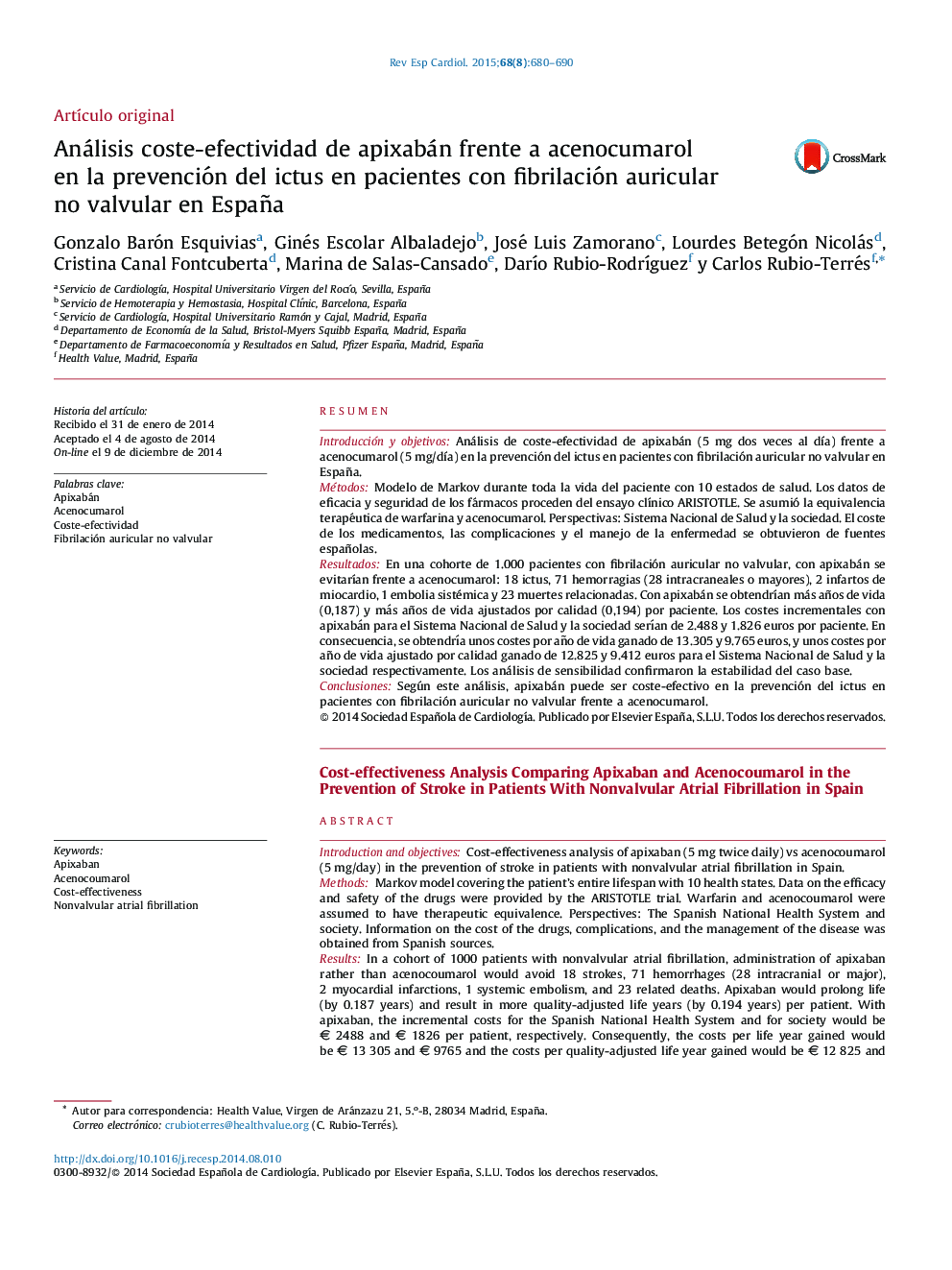| کد مقاله | کد نشریه | سال انتشار | مقاله انگلیسی | نسخه تمام متن |
|---|---|---|---|---|
| 3013354 | 1181850 | 2015 | 11 صفحه PDF | دانلود رایگان |

ResumenIntroducción y objetivosAnálisis de coste-efectividad de apixabán (5 mg dos veces al día) frente a acenocumarol (5 mg/día) en la prevención del ictus en pacientes con fibrilación auricular no valvular en España.MétodosModelo de Markov durante toda la vida del paciente con 10 estados de salud. Los datos de eficacia y seguridad de los fármacos proceden del ensayo clínico ARISTOTLE. Se asumió la equivalencia terapéutica de warfarina y acenocumarol. Perspectivas: Sistema Nacional de Salud y la sociedad. El coste de los medicamentos, las complicaciones y el manejo de la enfermedad se obtuvieron de fuentes españolas.ResultadosEn una cohorte de 1.000 pacientes con fibrilación auricular no valvular, con apixabán se evitarían frente a acenocumarol: 18 ictus, 71 hemorragias (28 intracraneales o mayores), 2 infartos de miocardio, 1 embolia sistémica y 23 muertes relacionadas. Con apixabán se obtendrían más años de vida (0,187) y más años de vida ajustados por calidad (0,194) por paciente. Los costes incrementales con apixabán para el Sistema Nacional de Salud y la sociedad serían de 2.488 y 1.826 euros por paciente. En consecuencia, se obtendría unos costes por año de vida ganado de 13.305 y 9.765 euros, y unos costes por año de vida ajustado por calidad ganado de 12.825 y 9.412 euros para el Sistema Nacional de Salud y la sociedad respectivamente. Los análisis de sensibilidad confirmaron la estabilidad del caso base.ConclusionesSegún este análisis, apixabán puede ser coste-efectivo en la prevención del ictus en pacientes con fibrilación auricular no valvular frente a acenocumarol.
Introduction and objectivesCost-effectiveness analysis of apixaban (5 mg twice daily) vs acenocoumarol (5 mg/day) in the prevention of stroke in patients with nonvalvular atrial fibrillation in Spain.MethodsMarkov model covering the patient's entire lifespan with 10 health states. Data on the efficacy and safety of the drugs were provided by the ARISTOTLE trial. Warfarin and acenocoumarol were assumed to have therapeutic equivalence. Perspectives: The Spanish National Health System and society. Information on the cost of the drugs, complications, and the management of the disease was obtained from Spanish sources.ResultsIn a cohort of 1000 patients with nonvalvular atrial fibrillation, administration of apixaban rather than acenocoumarol would avoid 18 strokes, 71 hemorrhages (28 intracranial or major), 2 myocardial infarctions, 1 systemic embolism, and 23 related deaths. Apixaban would prolong life (by 0.187 years) and result in more quality-adjusted life years (by 0.194 years) per patient. With apixaban, the incremental costs for the Spanish National Health System and for society would be € 2488 and € 1826 per patient, respectively. Consequently, the costs per life year gained would be € 13 305 and € 9765 and the costs per quality-adjusted life year gained would be € 12 825 and € 9412 for the Spanish National Health System and for society, respectively. The stability of the baseline case was confirmed by sensitivity analyses.ConclusionsAccording to this analysis, apixaban may be cost-effective in the prevention of stroke in patients with nonvalvular atrial fibrillation compared with acenocoumarol.Full English text available from:www.revespcardiol.org/en
Journal: Revista Española de Cardiología - Volume 68, Issue 8, August 2015, Pages 680–690